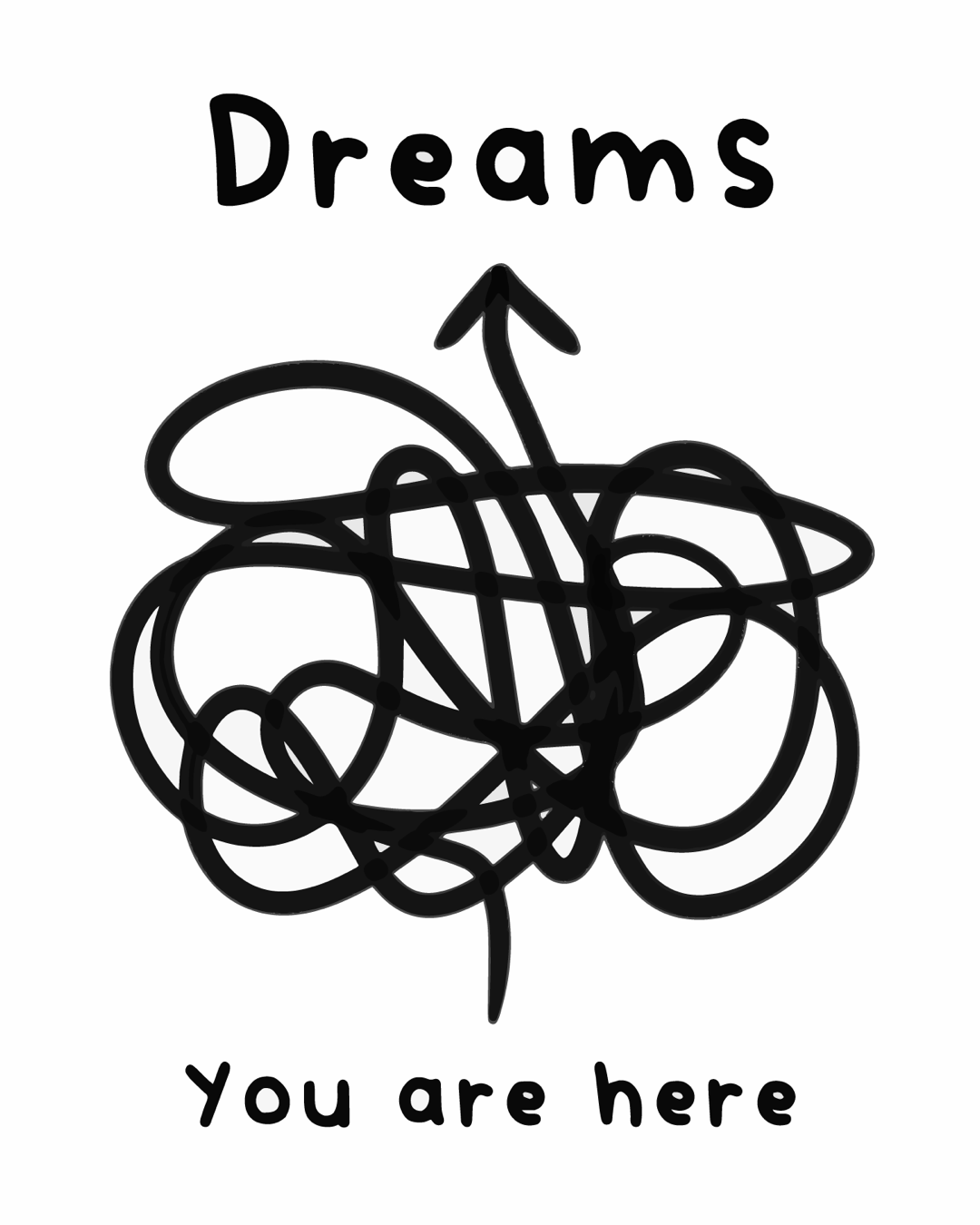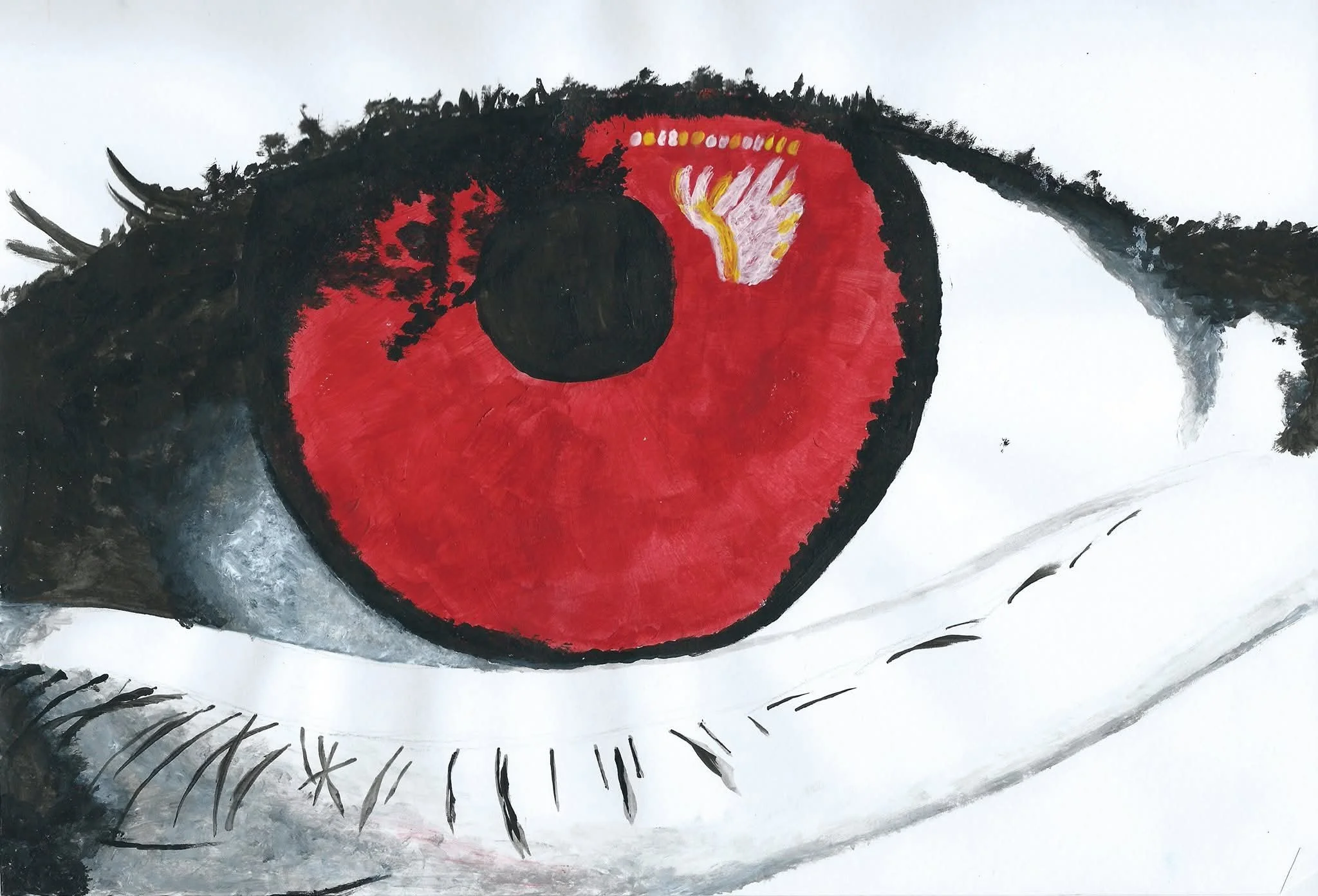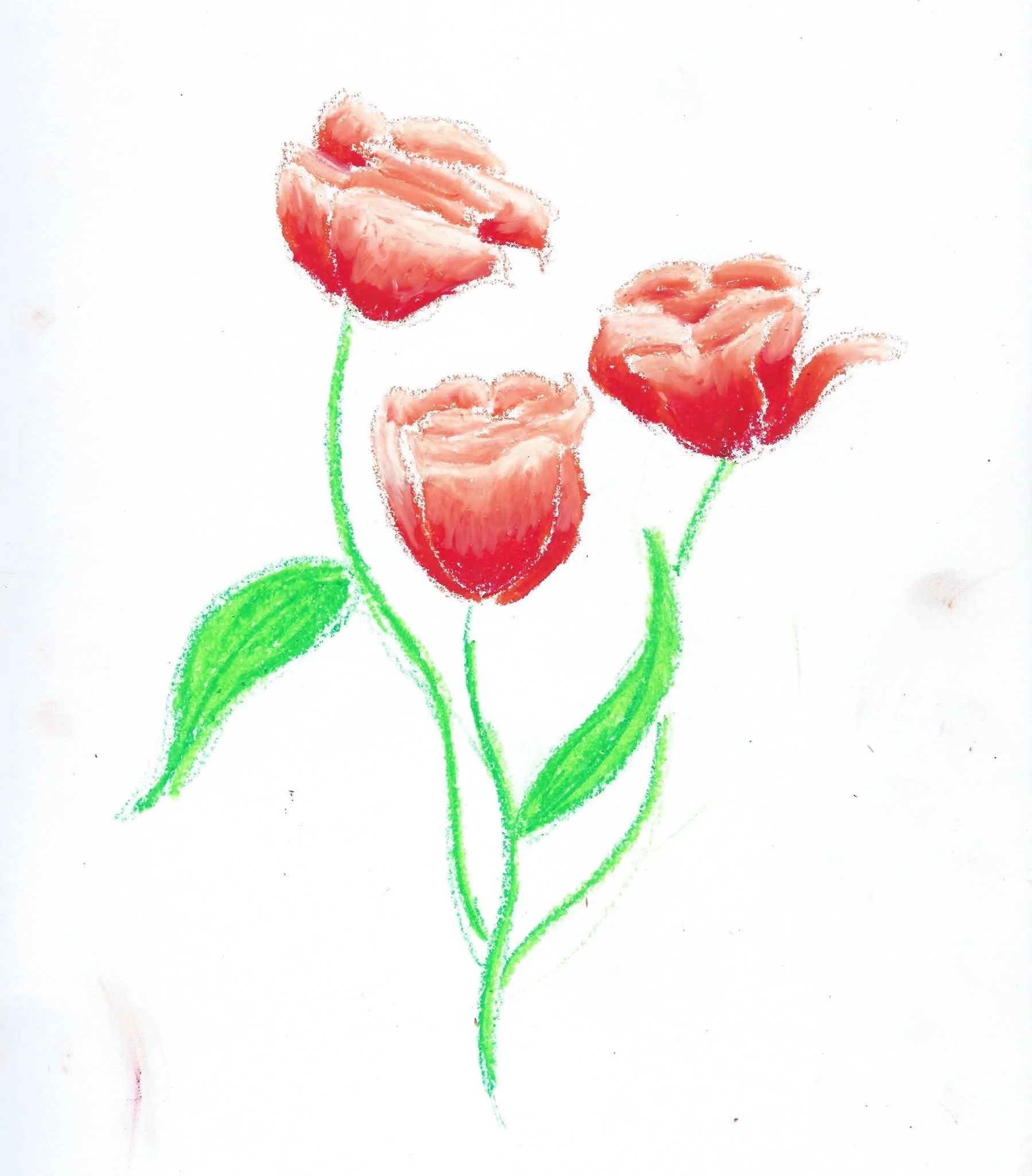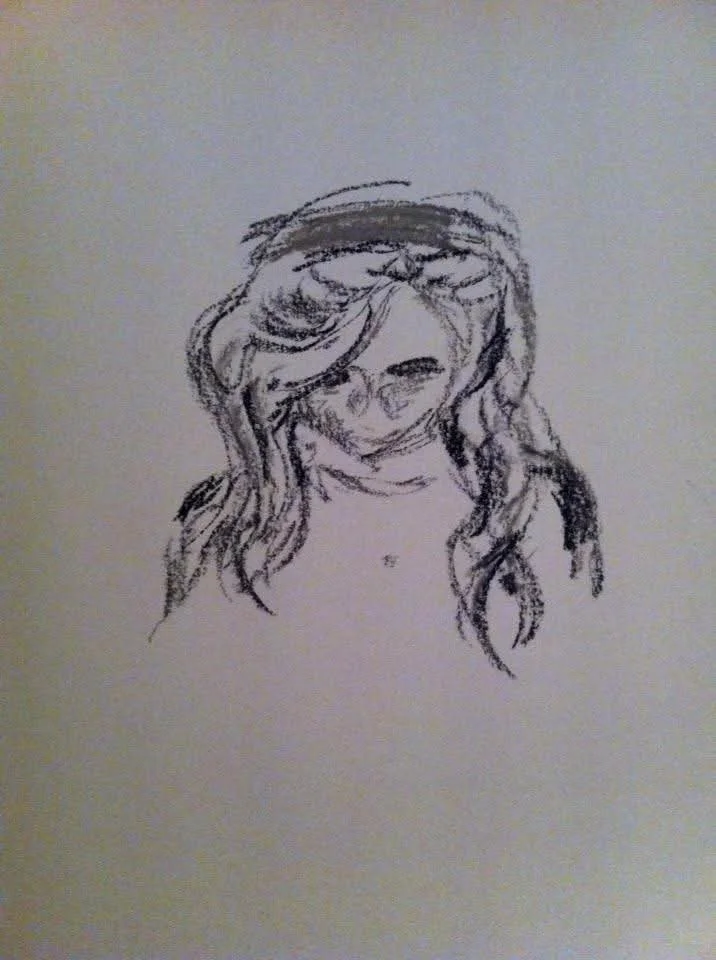Art Journey Part 1: The Foundation Years
Just over six years ago, I graduated from Edinburgh Napier University with a 2:1 in Digital Media and Interaction Design. I honestly couldn’t tell you much about the ceremony itself, I think I was too busy fretting about walking across the stage, but one moment from that day has stayed with me ever since.
It was the final speech, given by the Chancellor of my university at the time, David Eustace. He showed a photo of some graffiti he’d seen in New York: at the bottom, it said ‘You Are Here’, and at the top, ‘Dreams’, with a straight arrow connecting the two. He explained that this is how most people expect their journey to look—or at least how they hope it will go: a direct path from where they are to where they want to be.
Then he showed a second image. Same start and end points, but this time the straight line was replaced with a chaotic scribble. “This,” he said, “is the reality of most people’s journey.”
That stuck with me. To the point where I’ve never forgotten it. And now, six years later, sitting here and feeling like I’m still very much in the scribbled part of the journey, I can see just how true his words were.
While writing this blog post, I actually found my graduation ceremony on YouTube (for anyone curious you can watch it here). I had no idea it had been recorded. Watching myself back was a strange experience—I remember being so nervous crossing that stage (and I definitely looked it too). But what struck me most was thinking about the person I was then, compared to who I am now. And as I reflected on all the choices and moments that brought me to where I am, I realised that my journey into the scribble didn’t begin when I stepped off that stage. It started much earlier. Long before I even realised it had.
And that’s the journey I want to explore.
In this new blog series, I’m going to break that journey down into what I see as its six defining stages:
The Foundation Years
From Sketchbooks to Digital Art
Pivoting to 3D
Stepping into Freelance Work
Teaching Myself to Draw Again
The Start of Juniper Fox Designs
But first—let’s start at the very beginning, with the years that laid the foundations for everything that followed.
The Foundation Years
Some people say you’ll live a thousand different lives in one lifetime. Honestly, I feel like I’ve lived a thousand different art lives already—and I’m only 27. The work I created in high school and university is miles away from the art I do now, but looking back, there are definitely sprinkles of inspiration from those early years that trickled down into the work you see today.
I do want to apologise though for the lack of visuals for these years. I actually googled it and Google Photos was invented the year I left high school, which means most of the media I had taken in high school and before is now lost to the void but I’ve tried my best to find as much as I could to share with you. Because of that though, I’m sorry that the first part of this is quite text heavy, I promise there’s much more visuals towards the end!
“maybe the signs had been there all long...”
But I suppose if we really want to begin at the start, my journey really began when I was much younger.
Recently, at a market in Inverness, one of my old primary school teachers came up to my stall. She seemed surprised to see me, maybe even more surprised that, after 20 years, I still recognised her, but she wasn’t all that surprised to hear I’d ended up as an artist. In fact, she told me I’d always been a very creative child and that surprised me. I’d always thought I was bad at art as a kid. But she said that, as teachers, they can often spot creativity in children even if, at that stage, they’re not ‘good’ at art yet. That felt like a defining moment—realising that maybe the signs had been there all along, long before I saw them myself.
“I was just so happy - not to only have won but to have experienced something so creative and exciting.”
I still remember the first time I drew something I considered ‘good’. I was in Primary 7, around 11 years old, and we were learning how to draw side profiles of people. I drew a woman on a train, carefully following the steps we’d been taught, and I remember just staring at the finished drawing and thinking it actually looked… alright? Like actually resembled a real person somewhat. That feeling of pride, of creating something I hadn’t thought I was capable of, is still so vivid in my memory. It was probably one of the first key moments for me - the first time I felt that spark of “maybe I can do this” and it’s a feeling I’d chase again and again as I kept drawing.
That same year, I won a school competition to design an eco logo for a fundraising challenge. My design was printed on tote bags, which people could buy to raise money. Then, in my second year of high school, I won a t-shirt design competition and got to spend an afternoon at the print shop where they produced them. I even got to help print one of the shirts and a tote bag myself. They walked me through the whole process, let me design whatever I wanted, and I remember coming home that day on cloud nine. I was just so happy—not only to have won, but to have experienced something so creative and exciting.
As I moved into my teenage years, I started drawing more and more. I vividly remember summer 2011: I impulse-bought Speak Now by Taylor Swift for no reason other than I’d seen a friend have it. It became the soundtrack to a summer spent sketching characters from my favourite shows and attempting landscapes down at the beach. A couple of years later, Red would play in my bedroom during dark autumn evenings, while I sat at my desk trying to teach myself how to draw anime characters in my sketchbooks that were covered in My Chemical Romance stickers. Unfortunately, somewhere in all my house moves since, those sketchbooks were lost—a fact I’m still devastated about.
However, by digging through some very old group chats, I managed to recover a few lost drawings from those sketchbook days—including a very emo-inspired eye (my teenage emo phase might start becoming obvious soon…), some tulips done in oil pastels I’d received one Christmas, and one of my many attempts at drawing a person but in charcoal. I used to experiment with all sorts of different mediums—which I’ll explain more about shortly.
But it might surprise you that I didn’t seriously consider art as a career path until around third year of high school. It was actually my guidance counsellor who first suggested it to me, during a meeting where we reviewed all my subject scores. What makes me laugh, even now, is that art wasn’t even my best subject—it was actually Graphic Communication.
Graphic Communication was the only subject I got consistent A’s in, from Standard Grades all the way to Advanced Higher. In fourth year, I even won the Principal Prize Award for the highest exam marks in my year group. I absolutely loved that subject. It was where I first designed a magazine, had my first taste of 3D modelling, and built a Higher project portfolio that scored top marks.
“…wasn’t art supposed to be about self expression?”
In contrast, my art grades at the start were… not great. I spent most of my time in that class arguing with my art teacher about painting. No matter how many lessons we had on painting techniques, I just couldn’t get the hang of it. To this day, I’m still amazed by people who can paint—especially with watercolours, which I find near impossible to control. But my teacher insisted that the SQA (the body that marked all our coursework) wanted painting, and painting only. She warned me that using other mediums would risk my grade. But I argued: wasn’t art supposed to be about expression? Why should it matter if I used chalk, charcoal, or markers, as long as I was sticking to the brief?
I lost that argument and for our final assessment, we had to do a six-hour painting exam. I think I got a 4—which is basically a D. I managed to sneak some chalk and marker work into my portfolio alongside the painting, and combined with the written section, somehow scraped a 2 (B). Around this time though, I realised I much preferred drawing with ballpoint pen, and to this day, I can’t remember the last time I seriously sketched with a pencil. Another medium that, I’ve never been able to do well.
“I was young and stubborn. it wasn’t the best combination.”
Things changed in fifth year, when I moved to my favourite teacher: Mrs Stewart. She let me ditch painting entirely for my Higher Art project. I worked exclusively in chalk pastels and ended the year with an A. We also for the first time got to choose our subject matter, and me being 16 and heavily into my emo phase, decided to choose Funeral 😅. But for my final year, I had to return to my original teacher.
Now, I should say: despite all the arguments, I actually liked her. I understood that her strictness came from wanting me to succeed—she just didn’t like taking risks when grades were on the line. Meanwhile, I was young and stubborn. It wasn’t the best combination.
For our final project, we had to choose between still life or portraits. Since that proud moment drawing a side profile in Primary 7, I hadn’t improved at faces at all (despite countless attempts). I desperately wanted to be naturally good at it—but every time I didn’t improve quickly, I’d give up, convinced I just wasn’t capable. I’d believe that for years.
We were also given little side rooms where we could work on our projects whenever we wanted. That art room quickly became a safe haven for my two best friends and I. The three of us had all taken Advanced Higher Art, so we pretty much lived in that space—spending our breaks, lunchtimes, and every free period tucked away in that tiny room in the far corner of the school.
Apologies for the terrible image quality 🫠
So, I chose still life as my theme and focused on African objects— after all, we had plenty of them at home to use as references. That year, perhaps tired of arguing with me, my teacher gave me more freedom. And ironically, it was in this year—the one where I could finally avoid painting—that I figured out how to paint. Through fingerpainting, of all things. Using my fingers to paint the texture of a rope with acrylics somehow unlocked something in my brain. I finally understood how to manipulate paint. My final piece combined acrylics with other mediums, and while I still got told I’d fail if I didn’t work harder (she wasn’t wrong—I spent a lot of time in that art room chatting or napping under the table), I left with a B.
As high school came to an end, I had to decide what to do next. My mom suggested becoming an architect since I loved graphic communication so much but I wasn’t very inspired to design houses. I just enjoyed visualising them, not designing them. I also didn’t want to go to art school because I didn’t think it would help me get a job. Instead I decided I wanted to pursue digital art, explore animation, and try other computer-based creative fields.
I visited two university open days: Edinburgh Napier and Glasgow School of Art. I found Glasgow very overwhelming; the presentations were packed, there were only six spaces on the course I wanted, and the portfolio requirements felt intense. No matter how prestigious they were, I left knowing it wasn’t right for me.
Edinburgh Napier felt different. I already loved Edinburgh—it was familiar, thanks to summers spent visiting my cousin and I often travelled down to stay when going to gigs. And Napier’s course offered a broad mix: animation, sound, visual effects, and more. Perfect for someone like me, who just wanted to explore. I liked the campus too. It felt more relaxed—not something everyone looks for in a university, but it mattered to me.
So I applied to five courses, got unconditional offers from all of them, and in September 2015, I moved to Edinburgh to start the next chapter of my journey.







